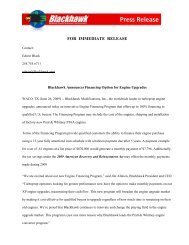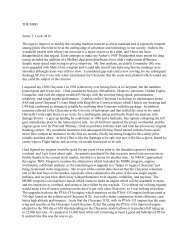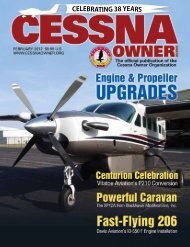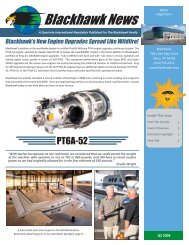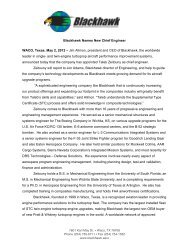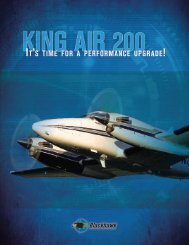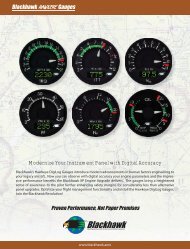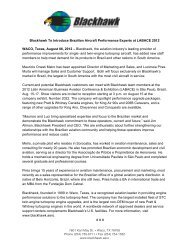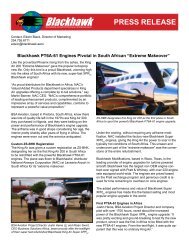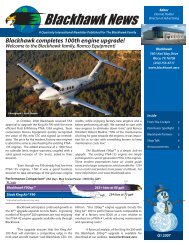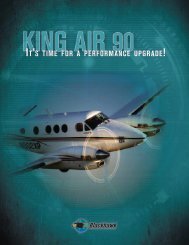Flying Blackhawk's 850 HP Caravan - Blackhawk Modifications, Inc.
Flying Blackhawk's 850 HP Caravan - Blackhawk Modifications, Inc.
Flying Blackhawk's 850 HP Caravan - Blackhawk Modifications, Inc.
You also want an ePaper? Increase the reach of your titles
YUMPU automatically turns print PDFs into web optimized ePapers that Google loves.
<strong>Flying</strong> <strong>Blackhawk</strong>’s<br />
Car<br />
By LeRoy Cook<br />
FAA approval of <strong>Blackhawk</strong> <strong>Modifications</strong>’ XP-42A engine upgrade<br />
for the Cessna 208B <strong>Caravan</strong> was obtained in July, with European<br />
approval following in September. The STC allows the Texas-based<br />
company to convert standard 675-hp <strong>Caravan</strong>s to a steroid-charged <strong>850</strong>-hp<br />
XP-42A version. We were fortunate enough to be able to fly the aircraft<br />
used for the certification testing at AOPA’s Aviation Summit in Hartford,<br />
Connecticut. As might be expected, it’s an eye-opening experience for<br />
anyone acquainted with the stodgy manners of a fully-laden ‘Van.<br />
The Walkabout<br />
Chris Dunkin, <strong>Blackhawk</strong>’s manager of flight operations, walked us<br />
around the familiar Cessna 208B’s exterior, just to acquaint us with the<br />
salient features of the conversion. The most obvious change is the use<br />
of a pair of short exhaust stacks, similar to those seen on other singleengine<br />
turboprops that are powered by the PT6A, rather than the single<br />
exhaust outlet, emptying into a secondary augmenter shroud, that Cessna<br />
employs with the stock PT6A-114. Extensive testing during the 210 hours<br />
16 TWIN & TURBINE DECEMBER 2011
avan<br />
An engine upgrade that takes a good Cessna<br />
airplane and makes it even better.<br />
DECEMBER 2011 TWIN & TURBINE 17
logged in <strong>Blackhawk</strong>’s recertification showed no CO<br />
contamination in the cockpit or cabin, owing to the<br />
precise “clocking” of the Frakes stacks installed on the<br />
PT6A-42A engine.<br />
Arizona Type Rating<br />
Quarter Page<br />
4/C Ad<br />
The test aircraft was fitted with a full APE (Aircraft<br />
Payload Extender) kit, which allows a gross weight<br />
increase to 9062 pounds (max landing weight is 9000<br />
pounds). The standard 208B ramp weight is 8785<br />
pounds. To take advantage of the weight increase, the<br />
XP42A approval requires installation of the APE kit’s<br />
minor changes, if the retrofitted aircraft is not already<br />
equipped with it. The APE kit includes larger mainwheel<br />
axles, an airflow fence on each wing’s outboard leading<br />
edge and a wavy aerodynamic device added to the<br />
inboard portion of each flap’s trailing edge.<br />
A 100-inch four-blade Hartzell propeller is part of the<br />
installation, replacing the 104-inch standard propeller.<br />
Standard TBO for the new engine is 3,600 hours. Credit<br />
Select Airparts<br />
Quarter<br />
Page<br />
4/C Ad<br />
18 TWIN & TURBINE DECEMBER 2011
is given for the service-life hours remaining on the<br />
traded-in PT6A-114. The original engine mount and<br />
accessories are used, but new vibration isolators are<br />
installed and the support ring’s mounts are increased<br />
from three to four. Typical weight increase is between<br />
20 and 40 pounds. The PT6A-42A engine is three inches<br />
longer, requiring installation of an all-new carbon-fiber<br />
composite cowling, which <strong>Blackhawk</strong> builds in-house at<br />
its Morgantown, Kentucky, composites facility.<br />
There’s ample workroom inside the cowling; someone<br />
listened to long-suffering maintenance technicians.<br />
Dunkin lifted the left cowling half to point out an<br />
engine oil sight glass, used to verify proper oil level<br />
without pulling a dipstick. A Concord RG-380E/44<br />
lead-acid battery is on the right side. The oil cooler in<br />
the nosecap is 40-percent larger than before and the<br />
adjoining air intake opening is bigger as well, with its<br />
angle changed to increase FOD dispersion.<br />
Aft of the firewall, most of the airplane is the same as<br />
it came from Cessna. The power quadrant in the cockpit<br />
is unchanged, but all the power gauges are replaced by<br />
<strong>Blackhawk</strong>’s own Digilog units that have digital vernier<br />
readouts as well as analog needle presentations. A<br />
new placard on the panel calls for a minimum of 130<br />
knots airspeed to be maintained when flying in icing<br />
conditions. Those are the only changes required.<br />
Dunkin related his experiences when conducting<br />
the natural icing tests. One sloppy autumn day,<br />
meteorologists directed him to a likely area in western<br />
Kansas, where icing was present between 5000 and<br />
9000 feet. He flew in the accumulating ice for 50<br />
uninterrupted minutes and never saw the airspeed<br />
deteriorate below 145 knots, even though the bootequipped<br />
aircraft picked up massive chunks of rime<br />
on unprotected areas. A meteorologist viewing photos<br />
of the flight pronounced it to be “near severe icing”.<br />
No further testing was needed.<br />
DECEMBER 2011 TWIN & TURBINE 19
Paul Bowen<br />
Half Page<br />
4/C Ad<br />
20 TWIN & TURBINE DECEMBER 2011
Going Up, Fast<br />
We climbed into the cockpit, pulled up the boarding<br />
ladders and went through the routine PT6A starting<br />
procedure; master on and fuel pump to normal, engage<br />
start switch and watch rotation begin on the Ng gauge,<br />
waiting for 15% Ng to introduce fuel. The lightoff and<br />
rise in rpm caused no more than a 750 C. indication<br />
on the ITT (start limit is 975 C). Once stabilized, we<br />
confirmed that the starter had been switched into<br />
generator mode and the avionics were flipped on.<br />
The cooperative Hartford, Connecticut tower offered<br />
to arrange for VFR flight following service as we exited<br />
their airspace to the east; Dunkin’s plan was to execute<br />
a max-performance climbout above Providence’s Class<br />
C environment. We quickly taxied to runway 21 for a<br />
prop governor test and advanced to high idle condition,<br />
extended ten degrees of flap and took the inertial<br />
separator handle out of “bypass” position. With the<br />
APE kit, extreme short-field takeoffs are approved with<br />
30 degrees of flap, versus 20 degrees for an unmodified<br />
airplane.<br />
Preferred<br />
Airparts<br />
Quarter<br />
Page<br />
4/C Ad<br />
The propeller wound up to 2000 rpm while we held<br />
the brakes, and we advanced the power lever to about<br />
2150 pounds of torque on the roll. The torque built to<br />
2200 as we lifted off at a leisurely 80 knots, halfway<br />
down the 4400-foot runway.<br />
Once past 95 knots, the flaps were brought up and I<br />
quickly accelerated the aircraft to 120 knots. Dunkin<br />
advised me to hold 115 in the climb; by doing so,<br />
visibility over the nose was nil. The VSI read 2000<br />
fpm initially, finally settling in at 1600 to 1700 fpm.<br />
<strong>Blackhawk</strong>’s brochure says the XP42A has double<br />
the climb rate of a standard <strong>Caravan</strong>, and when we<br />
compared numbers with the standard and modified<br />
charts, it appeared to be true; under similar conditions,<br />
a 675-hp 208B would manage around <strong>850</strong> fpm.<br />
With torque tweaked occasionally to keep 2200<br />
pounds pulling us upward, the ITT started out at 730<br />
degrees C. and rose to no more than 750 at the top of our<br />
climb, 11,500 MSL. Only about 8 minutes had elapsed<br />
since our sea-level liftoff. The -42A Pratt had kept its<br />
2200 pounds of torque until 10,500 feet. Temperature<br />
was about 16 degrees over standard ISA and takeoff<br />
weight was estimated at 7700 pounds.<br />
As we leveled off with 2100 pounds of torque and 750<br />
degrees on the ITT, the airspeed settled at 165 knots<br />
IAS, computing to a TAS of 202, while burning 460<br />
PPH of Jet-A. The standard 208B’s book showed that<br />
only 1370 pounds of torque would have been available<br />
at 12,000 feet, providing a TAS of about 158 knots.<br />
In all fairness, Dunkin pointed out, our TAS would<br />
have been ten knots or so less if we had been at full<br />
gross weight.<br />
Great Lakes<br />
Aero Products<br />
Quarter<br />
Page<br />
4/C Ad<br />
DECEMBER 2011 TWIN & TURBINE 21
With power reduced to 1900<br />
pounds torque, we lost about<br />
10 knots of speed, cutting fuel<br />
flow to 400 PPH. Dunkin then<br />
demonstrated a quiet-cruise mode<br />
by backing away a bit of torque<br />
and slowing the propeller rpm to<br />
1700, bringing torque back up to<br />
2200 pounds, but in a much quieter<br />
environment for the passengers.<br />
Handling at cruise remained trucklike<br />
but benign, just as the <strong>Caravan</strong><br />
has always been.<br />
We experimented with slowflight<br />
at 80 knots and full flaps, which<br />
turned out to be a thoroughly honest<br />
bit of flying, simply lighter on the<br />
control feel but still ponderous in<br />
response. We did not essay a full<br />
stall, but Dunkin assured us that<br />
nothing has changed over the simple<br />
Skyhawk manners we have come<br />
to expect in the 208. Because the<br />
FAA insisted on duplicating the<br />
certification criteria, a complete<br />
spin program has been flown,<br />
comprising some 115 spins.<br />
Going Down, Fast<br />
Because one of the major markets<br />
for the XP42A mod is for skydiving<br />
centers, we experimented with<br />
the skydive descent at flight idle,<br />
pushing over to reach the 180-<br />
knot redline. With the VSI pegged<br />
solid at 3000 fpm down, we timed<br />
an eardrum-splitting 4000 fpm<br />
descent, then quickly resumed a<br />
500 fpm letdown. Combining the<br />
improved climb rate and rapid<br />
descent, skydive centers will be<br />
able to take four loads per hour to<br />
the top of the non-oxygen altitudes.<br />
Cleared to land back at Hartford’s<br />
Brainard airport, we slowed to 175<br />
knots, where ten degrees flap was<br />
permitted, which reduced speed to<br />
150 knots so we could extend twenty<br />
degrees of flap. The final flap limit is<br />
125 knots. A defunct set of runways<br />
a few miles east of the airport, the<br />
former Rentschler Field from World<br />
War II, tempted us, but, fortunately,<br />
Dunkin caught my mistake before<br />
it became serious.<br />
Cessna avoiding any equivalentlevel-of-safety<br />
games when certifying<br />
its big single under FAR Part 23,<br />
preferring to meet the 61-knot Vso<br />
stall speed limitation with pure<br />
aerodynamic wizardry, at least at<br />
the standard airplane’s 8,500-pound<br />
landing weight.<br />
As with all <strong>Caravan</strong>s, approach<br />
and landing chores are simple; no<br />
landing gear to extend, no switches<br />
to throw, just slow to as little 80<br />
knots and drive to the runway. We<br />
indulged in a 90-knot “high-speed”<br />
22 TWIN & TURBINE DECEMBER 2011
final for the benefit of following<br />
traffic, followed by an easy<br />
touchdown on the tall gear. A bit of<br />
reverse brought us to a halt in short<br />
order; as it turned out, the inbound<br />
jet was bringing FAA Administrator<br />
Randall Babbitt to the Summit. As<br />
with all PT6A-powered airplanes,<br />
particularly those with four-blade<br />
props, one must be judicious with<br />
the power reduction to idle during<br />
landing, which produces a rapid<br />
increase in drag and a sudden<br />
touchdown.<br />
After shutting down and lowering<br />
the gangplank to debark, we felt<br />
it was apparent that <strong>Blackhawk</strong>’s<br />
XP42A modification takes the 208B<br />
<strong>Caravan</strong> to a new level of capability.<br />
To repeat CEO’s Jim Allmon’s<br />
statement, “Cessna built a good<br />
airplane, we just made it better”.<br />
We have to agree.<br />
T&T<br />
Turbines Training<br />
Center<br />
Half Page<br />
4/C Ad<br />
MAINTENANCE<br />
Northeast Air <strong>Inc</strong>.<br />
Sixth Page<br />
4/C Ad<br />
All scheduled and non-scheduled maintenance by our friendly, experienced technicians<br />
Qualified to work on Citation, KingAir, Twin Commander, and Pilatus<br />
Avionics<br />
Legacy: partial and full glass cockpit completions<br />
Garmin GTN650 and GTN750 installations<br />
XM Weather, traffic and mode S upgrades<br />
info@northeastair.com<br />
www.northeastair.com Portland Jetport (KPWM) Maine<br />
CRS #FTUR030E<br />
DECEMBER 2011 TWIN & TURBINE 23



